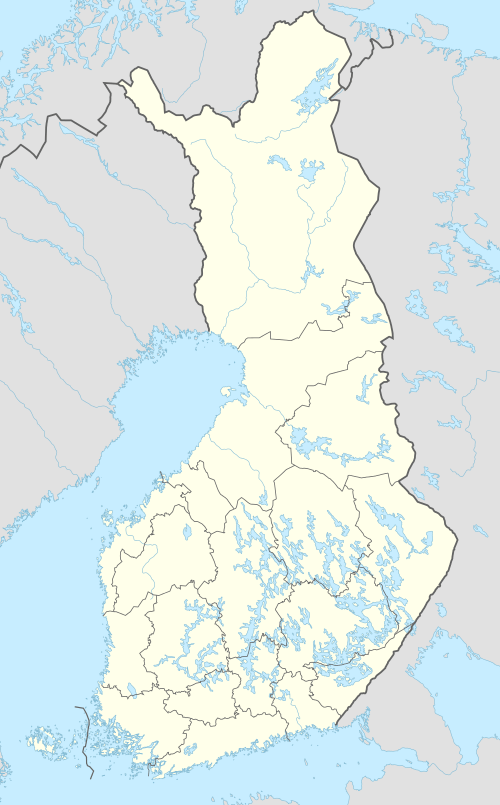Pyhäsalmi Mine
 Old tower and surrounding buildings of Pyhäsalmi mine | |
| Location | |
|---|---|
 Pyhäsalmi Mine | |
| Location | Pyhäjärvi |
| Region | Northern Ostrobothnia |
| Country | Finland |
| Coordinates | 63°39′31″N 26°02′28″E / 63.65861°N 26.04111°ECoordinates: 63°39′31″N 26°02′28″E / 63.65861°N 26.04111°E |
| Production | |
| Products | Copper, Zinc, pyrite, Silver, Gold |
| Type | Underground |
| History | |
| Opened | March 1, 1962 |
Pyhäsalmi Mine, the deepest base metal mine in Europe[1] (having depth of 1,444 metres or 4,738 feet[2]:5) is located at the Pyhäjärvi municipality in the south of Oulu province, Finland. The zinc and copper mine is owned by First Quantum Minerals, a Canadian mining corporation.[3]
In 2019, Callio Pyhäsalmi will take over the mine along with its facilities and the associated infrastructure.[4] The underground tunnels are being turned into laboratories and project facilities for businesses and research purposes.
History
The mine was opened in 1962 by Outokumpu, sold to Inmet mining in 2002, and obtained by First Quantum Minerals in 2013.[5][6] Mining activities are projected to end in 2019, but above-ground operations will continue until 2025.[3][4][7]
In 1958 a local farmer discovered gossan ore during a well construction. Shortly after a sample was delivered to Outokumpu Corporation for analysis and a more thorough geological survey was commenced, revealing a rich volcanogenic massive sulfide ore deposit (VMS-deposit) rich in zinc and copper. In 1959 a decision was made to open a new mine in the area and after few years of construction the mine was opened on March 1, 1962.[8]
Pyhäsalmi mine was worked as an open cast pit until 1967, when underground mining operations commenced. In 1975, open cast mining was stopped. During the years the underground mine has been made gradually deeper. The so-called Olli Shaft was completed in 1985, making the mine 730 metres (2,400 ft) deep. New ore was discovered yet deeper, and a depth of 1,050 metres (3,440 ft) was reached in 1996. Later a new shaft, called Timo Shaft was built to exploit the ore deposit between 1,050 and 1,440 metres (3,445 and 4,724 ft). Timo Shaft's construction work completed in 2001.[8] By 2003, 38.2 million tons of ore have been processed, containing 1.2% copper, 3.1% zinc, gold 0.46 grams per ton, and silver 14.6 grams per ton. 15.6 million tons of ore remained.
The mine currently houses CallioLab and the Centre for Underground Physics in Pyhäsalmi.
The mine is also the home of the worlds deepest sauna, at 1,410 metres (4,626 ft) underground.[2]:7 (Guinness World Records)
The waste piles are largely pyrite and contain sulphur, which Yara International uses for its production at Siilinjärvi.[9]
References
- ↑ Geological Survey of Finland: Pyhäsalmi Mine Archived 2008-02-01 at the Wayback Machine., retrieved on 2007-10-14
- 1 2 Peltoniemi, Juha (2005-02-05), Underground Physics in Pyhäsalmi Mine (PDF), retrieved 2014-10-01
- 1 2 "First Quantum Minerals Ltd. - Our Business - Operating Mines - Pyhäsalmi". www.first-quantum.com. Retrieved 2018-03-04.
- 1 2 Jokinen, Juha Veli (January 28, 2018). "Euroopan syvin kaivos lopettaa Pyhäsalmella - tilalle sirkkoja, salaattiviljelyä ja energiavarasto" (in Finnish). Retrieved 2018-03-04.
- ↑ "Pyhäsalmen kaivoksella haikea tunnelma". Kaleva.fi (in Finnish). January 20, 2001. Retrieved 2018-03-04.
- ↑ Harala, Samuli (March 24, 2013). "Kanadalainen kuparijätti ostaa myös Suomessa toimivan kaivosyhtiön". Yle Uutiset (in Finnish). Retrieved 2018-03-04.
- ↑ Mähönen, Erno (August 9, 2016). "Yara ja Pyhäsalmen kaivos pitkäaikaiseen sopimukseen pyriittitoimituksista | Kauppalehti". Kauppalehti (in Finnish). Retrieved 2018-03-04.
- 1 2 PYHÄSALMI MINE, Informational leaflet, Inmet Mining, 2002(?)
- ↑ "Yara kjøper gruveavfall – foredles til råstoff". Teknisk Ukeblad. Retrieved 2 September 2016.